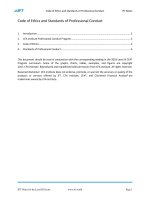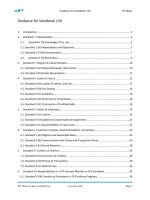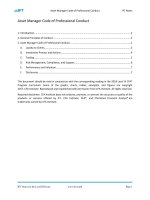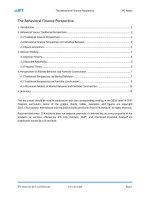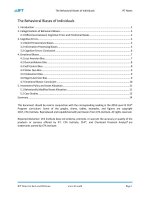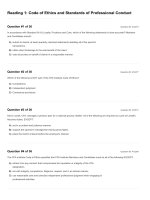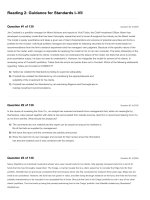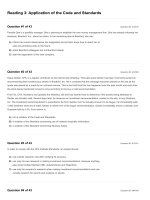CFA 2018 level 3 schweser practice exam CFA 2018 level 3 question bank 32 q
Bạn đang xem bản rút gọn của tài liệu. Xem và tải ngay bản đầy đủ của tài liệu tại đây (171.81 KB, 17 trang )
CFA LEVEL-III, PRACTICE QUESTIONS (LOS # 31)
Reading 31: (Monitoring and Rebalancing)
| Questions
Question 1 - #92369
Which of the following strategies is most likely to outperform if a stock market reversal is NOT
expected to occur?
A) Constant proportion.
B) Buy and hold.
C) Constant mix.
Question 2 - #92659
Mimi Smith, a client of Osborne Capital, Inc., believes that her portfolio should be rebalanced. She
supports her claim by stating that she just won the lottery and wants to retire 10 years earlier than
before. Does she have a valid claim?
A) No. Not enough information is given to determine.
B) Yes. Her wealth and time horizon have changed.
C) Yes. Her time horizon has changed.
Question 3 - #92396
Constance Frye, a portfolio manager for the money-management unit of Freedom, a broker-dealer, is
concerned about the positioning of her managed accounts. Economic indicators are mixed, and stock
valuations are all over the map. Frye is not confident about the direction the market will take over the
next year, but she is very confident that volatility will increase.
Overall, Frye is satisfied with her asset allocations, but she is less certain about her rebalancing
strategies. Freedom is a large shop, and she is responsible for several hundred portfolios. The
company generally uses automated trading programs for rebalancing, and Frye’s chief concern is that
the wrong program will be used, and some portfolios will not adjust well.
Frye decides to stress-test her rebalancing strategies to see how they would respond to a range of
market movements. She starts with a basic portfolio containing just stocks and cash. Here is what she
learns:
Stress
Rebalancing Strategy A
Rebalancing Strategy B
Sustained upward market Portfolio value rises but lags
Portfolio rises strongly
Strategy B
Sustained downward
Portfolio value falls and lags
Portfolio falls to a certain level, then
market
Strategy B
holds steady
Volatile, directionless
Portfolio value rises
Portfolio value declines
market
Stanley Montone trades stocks for Freedom. Montone is busy today, making trades to rebalance
portfolios managed by Freedom’s money-management unit. He makes the following buys:
Security
Bid Price Ask Price Trading Price No. of Shares
Flanders Fudge
$45.78 $45.96 $45.90
1,400
Grossman Golf
$8.45
$8.52
$8.53
600
Hedger Health Care $115.67 $115.81 $115.79
150
When Montone trades, he transacts through an intermediary. Normally, he buys shares controlled by
the intermediary, who in turn purchased them from someone else.
Part 1)
Montone trades in:
A) a quote-driven market.
B) a brokered market.
C) an electronic crossing network.
Part 2)
Assuming a portfolio begins at a mix of 50% stocks and 50% cash, which of the following
rebalancing strategies could allow the portfolio balance to fall to $0?
A) Only buy and hold.
B) Only constant proportion.
C) Only constant mix.
Part 3)
Which statement regarding Montone’s trades is least accurate?
A) He is trading in a highly liquid market.
B) He provided liquidity in two of the trades.
C) He did not get best execution.
Part 4)
The portfolio-rebalancing strategies Frye is testing are most likely:
Strategy A
Strategy B
A) constant mix
constant
proportion
B) buy and hold
constant
proportion
C)
constant
proportion
constant mix
Part 5)
Which rebalancing strategy does NOT connect risk tolerance to wealth?
A) Buy and hold.
B) Constant proportion.
C) Constant mix.
Part 6)
The weighted average effective spread for Montone’s three stock trades is closest to:
A) $0.1056.
B) $0.0712.
C) $0.0833.
Question 4 - #93182
The cost of not rebalancing the portfolio includes all of the following EXCEPT:
A) holding assets that no longer fit the needs of the client.
B) the costs of desirable trades that never happen.
C) holding an overpriced asset.
Question 5 - #93074
Darrell Woolaver is the founding principal for Woolaver Capital Management. In his marketing
materials, Woolaver makes it a point to tell clients the two primary responsibilities he has as a
fiduciary when it comes to portfolio management.
Responsibility 1: Construct each client’s portfolio so that it offers the maximum return per unit of
risk.
Responsibility 2: Regularly monitor the investor’s portfolio to make sure it continues to meet the
client’s needs.
With respect to his statements about the responsibilities Woolaver has as a fiduciary when it comes
to portfolio management, Woolaver is:
A) incorrect with respect to Responsibility 1, and incorrect with respect to Responsibility 2.
B) incorrect with respect to Responsibility 1, but correct with respect to Responsibility 2.
C) correct with respect to Responsibility 1, and correct with respect to Responsibility 2.
Question 6 - #92037
Allen and Hanes joined Tacticon five years ago, fresh out of college. They are now both convinced
that properly timed allocation shifts can add value to the investment process. The equity market
trended upward for the first three years of their tenure, but has been slowly declining ever since. In
spite of the lackluster performance of the markets in general, the firm has produced exceptional
annual and 5-year trailing returns. Both analysts are certain that Tacticon’s ability to generate
positive alpha is the result of a superior investment system.
Ridley wants Allen and Hanes to record the specifics of Tacticon’s investment process for internal
use. He also wants them to compile a document explaining a variety of allocation techniques to be
used by the marketing staff and portfolio managers when working with prospects and clients.
While conducting his research, Allen notes that certain dynamic strategies can use a mathematical
formula to determine the amount of equities that should be held. Specifically, one formula Allen
finds is:
Allen decides to organize his thoughts about asset allocation by constructing a matrix that compares
some of the different strategies. His first draft is detailed in Exhibit A below.
Exhibit A – Dynamic Asset Allocation Strategies
Strategy
Shape of Payoff Diagram Performs Well In
Buy and Hold
Straight line
Upward trending markets
Constant Mix
Concave
Constant Proportion Portfolio Insurance (CPPI)
Part 1)
Hanes is having difficulty completing Exhibit A as he is unsure of the shape of the payoff diagram
for CPPI. The correct shape for the CPPI payoff diagram is:
A) straight-line.
B) concave.
C) convex.
Part 2)
Which strategy in Exhibit A provides the greatest benefit when markets are trending up or down
with little oscillation?
A) Buy and hold strategy.
B) Constant proportion portfolio insurance.
C) Constant mix strategy.
Part 3)
Allen realizes that his firm’s trading success might have been due to use of the mathematical formula
he found. Since Tacticon’s performance was exemplary over the past five years, which value of “m”
was probably chosen?
A) Greater than 1.
B) Equal to 1.
C) Less than 1.
Part 4)
Constant mix rebalancing involves:
A) holding either all cash or all equities.
B) buying the asset whose price rises; selling the asset whose price falls.
C) buying the asset whose price falls; selling the asset whose price rises.
Question 7 - #93107
A constant mix strategy will outperform a buy and hold strategy in a(n):
A) flat but oscillating market.
B) upward oscillating market.
C) downward oscillating market.
Question 8 - #91594
Dillard Decker is 72, and he doesn’t seem to be getting any older, just more ornery.
Decker started his career as a busboy and clawed his way up the industry ladder until he owned a
chain of restaurants and a variety of other real-estate holdings. After a heart attack at age 57, Decker
retired for health reasons. For the last 15 years, Decker has trained three hours a day. He lost 50
pounds and started running in marathons. When he turned 70, Decker cut back to five marathons a
year.
Now it’s the 15th of the month, and Decker has just arrived for his monthly meeting with Derek Hass,
a partner at Conwell Consulting and Investments. As usual, Decker started the meeting with an
acerbic complaint about Hass’s conservative approach. Hass has discretionary authority over
Decker’s assets, though sometimes it does not feel that way. Hass has invested Decker’s money
using the following target allocation:
40% in large-cap stocks.
10% in small-cap stocks.
10% in foreign stocks.
10% in a long-short equity hedge fund.
20% in long-term corporate bonds.
10% in short-term bonds.
Decker lives comfortably on the dividends from his stock investments and would prefer to have no
fixed-income securities at all. Hass sighs, knowing that after Decker leaves, he’ll have to meet with
his boss to justify why he keeps so little of Decker’s assets in bonds.
Normally Decker and Hass snipe at each other for an hour before the retiree stomps off. Today,
however, Decker gets right down to business and tells Hass that he wants to invest about 10% of his
assets in his nephew’s restaurant business. Decker regales Hass with stories about how smart and
ambitious his nephew has become. The nephew attended a cooking school after high school, then
went to college and just recently earned his MBA. Decker is very impressed with the man’s
marketing plan and agreed to fund the restaurant concept.
In addition, Decker wants to diversify his holdings by investing in real estate. A former colleague of
Decker’s is seeking backers for a resort on the Caribbean island of Lizan. Decker is interested in
buying a 25% stake, which would require another 10% of his assets.
Hass knows a little about the man building the resort, but has not heard any details about the
development. As a real-estate investor himself, he knows that real-estate prices on Lizan and other
nearby islands are likely to soar over the next 10 years on the strength of an improved regulatory and
tax climate as well as rising demand for tourism.
Decker wants to sell the bond holdings to fund these investments, while Hass would like to pare
down the stock holdings. They compromise at a 50/50 split, agreeing to sell half of the long-term
bonds and raise the rest of the funds from the sale of large-cap stocks, reducing the target weightings
accordingly. After Decker leaves, Hass assesses the portfolio and sells the stocks and bonds he
believes are overvalued, then submits a memo to the accounting department requesting checks for
Decker’s nephew and the real-estate developer. He then calls the developer to get a prospectus on the
real-estate venture. After reviewing the details, he purchases a 2% interest for himself.
After the flurry of activity, Hass reviews Decker’s portfolio and considers that today is a good day to
rebalance. Here are Decker’s current allocations:
Asset Class
Portfolio Weighting
Large-cap stocks 35%
Small-cap stocks 10%
Foreign stocks 6%
Hedge fund
13%
Long-term bonds 6%
Short-term bonds 10%
Cash *
20%
* Slated for outside investment.
Hass decides to sell some large-cap stocks and use the funds to purchase foreign stocks and longterm bonds. As he is putting the trades through, Hass wonders whether there is a better strategy for
rebalancing.
Part 1)
With regard to Decker’s account, Hass is:
A) an information-motivated trader.
B) a liquidity-motivated trader.
C) a value-motivated trader.
Part 2)
If Hass’s rebalancing consists only of selling large-cap stocks and buying long-term bonds and
foreign stocks, he:
A) is using a convex strategy.
B) has not set optimal corridor widths.
C) is using a tolerance band of more than 3%.
Part 3)
Hass expects the market to trend sharply lower. Assuming he wants to maximize account value but is
not willing to simply get out of stocks altogether, which rebalancing scheme should he use?
A) Buy and hold.
B) Constant mix.
C) Constant proportion.
Part 4)
Which of the following reasons best justifies Hass’s asset allocation for Decker? Decker’s:
A) health.
B) wealth.
C) complaints about the allocation.
Part 5)
What rebalancing strategy does Hass use?
A) Constant mix.
B) Calendar rebalancing.
C) Constant proportion.
Part 6)
Hass’s actions regarding the real-estate development represent:
A) no violation of Hass’s fiduciary duties.
a violation of Hass’s fiduciary duties because he failed to assess the details of the realB)
estate investment.
a violation of Hass’s fiduciary duties because he failed to assess the details of both the
C)
real-estate investment and the restaurant investment.
Question 9 - #92357
Which of the following strategies is most appropriate for an investor whose risk tolerance drops to
zero when the value of the portfolio drops below a floor value?
A) Both of these responses are correct.
B) Constant proportion portfolio insurance.
C) Buy and hold.
Question 10 - #92824
Which of the following statements correctly identifies a benefit of active management?
A) Trading provides liquidity to capital markets.
B) Most portfolio managers can add value through active management.
C) Studies have shown more frequent rebalancing to increase portfolio returns.
Question 11 - #92399
Which of the following strategies is most likely to outperform if stock market reversals are expected
to occur?
A) Buy and hold.
B) Constant proportion.
C) Constant mix.
Question 12 - #92323
Which of the following statements regarding a constant mix portfolio strategy is least accurate?
The slope of the exposure diagram (y-axis = desired stock position, x-axis = asset value)
A)
for a constant mix strategy is between zero and one.
B) Under a constant mix strategy, stocks are purchased as the stock market rises.
C) Under a constant mix strategy, stocks are purchased as the stock market falls.
Question 13 - #92476
A constant mix strategy:
A) performs much like a covered call position.
B) performs poorly in flat, oscillating markets.
C) exhibits good upside potential.
Question 14 - #92613
Which of the following statements regarding disciplined rebalancing is CORRECT? Disciplined
rebalancing (e.g., maintaining an asset mix at 60% stocks and 40% bonds):
A) allows for the possibility of a drifting mix.
B) eliminates periodic departures from the policy mix.
C) prevents substantial gains from market timing.
Question 15 - #92453
In a flat but oscillating market, which asset allocation strategy outperforms?
A) Buy and hold.
B) Constant proportion portfolio insurance (CPPI).
C) Constant mix.
Question 16 - #92875
Which of the following statements about asset allocation strategies is least accurate?
The constant proportion portfolio insurance (CPPI) strategy has a payoff diagram similar
A)
to that of a protective put.
B) The constant proportion portfolio insurance (CPPI) strategy is a convex strategy.
Strategies for which the slope of the exposure diagram is greater than one give rise to
C)
concave payoff diagrams.
Question 17 - #92741
Assume that $10 million of stocks and cash is being managed according to a constant mix strategy.
Assume further that the desired stock-to-total portfolio value ratio for the strategy is 0.75. Which of
the following is closest to the amount of stock that must be bought or sold if the value of the stock
component of the portfolio increases by $500,000?
A) $500,000 must purchased.
B) $500,000 must be sold.
C) $125,000 must be sold.
Question 18 - #92787
Which of the following statements regarding asset rebalancing approaches is least accurate?
A) A "constant mix" asset allocation strategy is also referred to as a "drifting mix."
Disciplined rebalancing strategies tend to beat momentum-based strategies over the long
B)
term.
C) Market timing strategies tend to perform poorly relative to a constant mix strategy.
Question 19 - #92143
Annabelle Sellier, CFA, manages the fixed-income portfolio of a large research endowment fund.
Sellier’s 2002 allocation among fixed-income assets, the returns she realized from these investments,
and benchmark returns for each of the asset classes are presented in the table below.
Fixed-income allocation and returns
Asset Class
Allocation Realized Returns (%) Benchmark Returns (%)
U.S. Treasury 0.35
10.28
9.78
U.S. Corporate 0.40
9.57
8.37
U.S. Agency 0.25
10.05
10.20
What is Sellier’s alpha for 2002?
A) 9.3210%.
B) 0.6175%.
C) 9.9385%.
Question 20 - #92512
All of the following are costs associated with rebalancing a portfolio EXCEPT:
A) brokerage commissions.
B) deferral costs.
C) tax costs.
Question 21 - #92234
Constant mix strategy:
A) requires purchase of a stock as the stock value rises.
B) is preferable to a buy and hold strategy when the market reverses direction.
C) requires purchase of bonds as stocks fall in value.
Question 22 - #92020
Which of the following strategies is also referred to as insured asset allocation?
A) Constant proportion portfolio insurance (CPPI).
B) Constant mix.
C) Concave strategy.
Question 23 - #93063
A constant proportion portfolio insurance (CPPI) strategy:
A) performs well in flat, oscillating markets.
B) represents the purchase of portfolio insurance.
C) represents the sale of portfolio insurance.
Question 24 - #92160
Which of the following statements regarding rebalancing strategies that have convex payoff
diagrams (y-axis = portfolio value, x-axis = stock market value) is CORRECT? Convex rebalancing
strategies:
A) include the constant mix strategy.
B) do well in flat, but oscillating, markets.
C) sell stocks as prices fall and buy stocks as prices rise.
Question 25 - #93084
Which of the following choices best describes the reason(s) why a fiduciary must monitor a
portfolio?
The risk tolerance of the investor may change over time.
Economic conditions are likely to change over time.
The investor’s liquidity requirements may change over time.
The client portfolio may need to respond to legal or regulatory changes.
A) I only.
B) I, II, III and IV.
C) II only.
Question 26 - #92558
Which of the following would NOT be a condition for rebalancing a portfolio?
A) Impact of trades on security prices.
B) Changing time horizons.
C) Availability of new asset classes.
Question 27 - #92311
Anita Malley and James Upshaw are portfolio managers for Washington Square Asset Management.
Malley and Upshaw are debating the merits of rebalancing an asset within a portfolio to its target
portfolio weight versus creating a tolerance band for each asset. Malley states, “Rebalancing a
portfolio so that target weights are maintained may force the manager to provide liquidity to the
market, resulting in poorly timed trades and higher trading costs.” Upshaw states, “It does not matter
if we rebalance to maintain target portfolio weights or create tolerance bands; if we use either
method, the portfolio will require constant monitoring.”
With regard to their statements:
A) Malley is incorrect; Upshaw is correct.
B) Malley is correct; Upshaw is incorrect.
C) Malley is correct; Upshaw is correct.
Question 28 - #93283
Consider two identical $10,000 portfolios, each with a 75% allocation to stock and a 25% cash
allocation. One portfolio is being managed to a buy and hold strategy with an initial stock/total value
ratio of 0.75. The other is being managed to a constant mix strategy with a desired stock/total value
ratio of 0.75. Beta for the stock component of both portfolios is equal to one. Now, assume that the
stock market instantly decreased from an index value of 1,000 to 900 and, a short while later, jumped
back to the 1,000 level. The difference between the final value of the two portfolios is closest to
which of the following?
A) The constant mix portfolio will be worth $187.50 more than the buy-and-hold portfolio.
There is no difference between the final value of the buy-and-hold portfolio and the
B)
constant mix portfolio.
C) The constant mix portfolio will be worth $20.83 more than the buy-and-hold portfolio.
Question 29 - #92935
Stuart Steinberg, a portfolio manager for Weber Capital Advisors, uses a percentage-of-portfolio
rebalancing approach when rebalancing his client portfolios, but is unsure how to set the optimal
corridor width for each asset class. Steinberg is evaluating the following factors for a particular asset
class.
Factor 1: The asset class has a tendency to be extremely volatile.
Factor 2: The asset class has a low trading volume and a high bid-ask spread.
When comparing the asset class to the rest of the portfolio, the volatility for the rest of the
Factor 3:
portfolio is high.
Which of the factors would lead Steinberg to set a large corridor for the asset class?
A) Factors 1 and 2 only.
B) Factor 2 only.
C) Factors 2 and 3 only.
Question 30 - #92368
Which of the following client portfolios is most likely to generate the highest trading costs?
Rebalancing
Discipline Employed
Portfolio Allocation
40% Corporate Bonds; 30% MortgageRebalanced on the last day of each calendar
A
Backed Bonds; 30% Government
quarter.
Bonds
25% Domestic Equity; 25% Real
Rebalanced within an allowable range of 5% for
B
Estate; 25% International Equity; 25%
each asset class.
Corporate Bonds
40% Domestic Equity; 30%
Rebalanced to precise target weights if allocation
C
International Equity; 30% Government
strays from target.
Bonds
A)
B)
C)
Portfolio A.
Portfolio B.
Portfolio C.
Question 31 - #92268
Michelle Nack has a problem. She just took over for a portfolio manager who bolted
unceremoniously from money manager Masters and Ickes, leaving his accounts in disarray. Nack has
been tasked with sorting out the mess.
She has connected most of the investment policy statements with the appropriate accounts, but three
accounts, each valued at $100,000, are not named. The accounts contain the following assets:
Portfolio A Portfolio B Portfolio C
Large-Cap Stocks
$55,000 $45,000 $70,000
Small-Cap Stocks
$10,000
$10,000
Private Equity
$15,000
Commodities
$10,000
Real Estate
$5,000
Long-Term Corporate Bonds $20,000 $25,000
Short-Term Corporate Bonds $10,000 $5,000
$5,000
Cash
$5,000
$5,000
$5,000
Nack is trying to match the accounts with clients for whom no other accounts have been found.
Johnson is a 55-year-old executive who was recently promoted to a senior-management position at a
pharmaceutical company.
Kent is a 26-year-old assistant manager of a restaurant.
Lerner is a 70-year-old owner of a copper mine who retired from the business 20 years ago.
After Nack has been on the job for six months, she is still not sure who owns Portfolio A. However,
substantial moves of the market suggest that it is time to rebalance the portfolio. The portfolio notes
infer that a CPPI strategy should be used, with a coefficient of 2 and a $70,000 floor. Here are the
portfolio weights after six months:
Portfolio A
Large-Cap Stocks
$47,600
Small-Cap Stocks
$9,750
Long-Term Corporate Bonds $20,500
Short-Term Corporate Bonds $10,150
Cash
$5,000
Another six months has passed since Nack rebalanced Portfolio A. The market has been quite
volatile, and Nack wants to rebalance again. Because she still does not know to whom the portfolio
belongs, she decides to reconsider the rebalancing strategy in an effort to maximize portfolio return.
The current allocation is as follows:
Portfolio A
Large-Cap Stocks
$58,950
Small-Cap Stocks
$12,500
Long-Term Corporate Bonds $18,400
Short-Term Corporate Bonds $10,050
Cash
$5,000
Nack decides to rebalance using a constant-mix strategy this time, reasoning that the original asset
mix was what the first portfolio manager considered best for the unnamed client. Going forward,
Nack isn’t sure about the market’s direction. The research department at Masters and Ickes has
produced divergent forecasts, with some analysts projecting a flat market with lots of volatility and
some projecting a sustained upward trend.
When Nack submits her trades to the Masters and Ickes trading desk, they are handled by Wilbur
Wallace, a 30-year veteran trader. Wallace handles most of the company’s rebalancing trades, and he
is almost always more concerned about the price of trades than the timing. For that reason, he
generally uses limit orders.
Part 1)
Which investors appear to be the best fit for:
Portfolio B? Portfolio C?
A) Lerner
Johnson
B) Johnson
Lerner
C) Johnson
Kent
Part 2)
After Nack rebalances Portfolio A the first time, its bond holdings should:
A) rise by $1,600.
B) rise by $11,350.
C) decline by $1,550.
Part 3)
Wallace is a:
A) liquidity-motivated trader.
B) passive trader.
C) value-motivated trader.
Part 4)
The owner of Portfolio B appears least concerned about:
A) liquidity.
B) income.
C) volatility.
Part 5)
After rebalancing Portfolio A the second time, if Nack’s goal is to maximize return potential while
limiting potential loss of principal, her best rebalancing strategy is:
A) buy and hold.
B) constant mix.
C) constant proportion.
Part 6)
When Nack rebalances Portfolio A the second time, the portfolio’s stock allocation is most likely to
fall by:
A) 3.33%.
B) 3.11%.
C) 6.45%.
Question 32 - #92051
Carl Allen, CFA, has been assigned the task of documenting some of his company’s asset allocation
techniques. After the firm receives accolades in a recent trade magazine article highlighting firms
with innovative trading strategies, Allen’s supervisor decides it is time the firm began formally
documenting how properly timed allocation shifts can add value to assets under management. Allen
decides he will not only document the firm’s specific allocation adjustment strategies, but will also
compile a document listing various allocation techniques. Allen decides to begin with input factors
such as investor risk tolerance and market conditions and work his way to specific techniques
designed to take advantage of various opportunities. His overall plan is to work from theoretical
concepts to specific applications.
Part 1)
One of the first concepts Allen has to explain is the idea of holding an “optimal” portfolio. In his
mind, Allen decides he has to adequately explain the two main factors that will allow an investor the
ability to hold an optimal portfolio. Which of the following will dictate the selection of an investor’s
optimal portfolio?
A) The global minimum variance portfolio.
Any intersection between an investor's indifference curve and the investment opportunity
B)
set.
The tangential intersection between an investor's indifference curve and the efficient
C)
frontier.
Part 2)
Allen has determined there are differential postures an asset manager can take, depending upon
whether market conditions are trending up, trending down, or staying relatively level with significant
volatility. Which rebalancing strategy provides the greatest benefit when markets are trending up or
down with little oscillation?
A) Constant proportion portfolio insurance strategy.
B) Constant mix strategy.
C) Buy and hold strategy.
Part 3)
While conducting his research, Allen determines that some dynamic strategies can use a
mathematical formula that can easily determine the amount of assets one invests in equities.
Specifically, one formula Allen discovers is:
$ Invested in stock = m x (assets – floor)
where:
m
= stock investment multiplier
assets
= total assets held in the portfolio (TA)
floor
= the minimum allowable portfolio value (F) (zero risk level)
assets - floor = cushion or funds that can be put at risk
Realizing that his firm’s trading strategies were highlighted in the recent edition of a trade magazine
due in part to some timely exposure increases in trending markets, Allen begins to document how his
firm applies this particular mathematical formula. Since Allen’s firm’s performance seems
exemplary in a trending market, which value of “m” was probably chosen?
A) Greater than 1.
B) Equal to 1.
C) Less than 1.
Question 33 - #92254
Which of the following statements about convex and concave strategies is least accurate?
A) The constant mix payoff curve is concave.
B) No downside protection exists for constant mix strategies.
C) For constant proportion portfolio insurance (CPPI) strategies, the payoff curve is concave.
Question 34 - #92258
Which of the following statements concerning dynamic strategies for asset allocation is least
accurate?
Constant proportion portfolio insurance sells stocks as they fall and buys stocks as they
A)
rise.
B) A constant mix strategy is a concave strategy.
C) Constant mix sells stocks as they fall and buys stocks as they rise.
Question 35 - #92306
Tyrone Wilkins and Deborah Ortiz are portfolio managers for Meabon Asset Management. Both
Wilkins and Ortiz believe that rebalancing is an important part of portfolio management, but are
unsure which rebalancing method would be best for their respective clients. Wilkins wants to
maintain his client’s exposure to systematic risk factors, but does not want to spend his time
constantly monitoring his client’s portfolio. Ortiz is most concerned that two or more asset classes in
the portfolio could stray too far from the portfolio’s target allocation. Given their concerns, which
rebalancing method would be best for Wilkins and Ortiz respectively?
Rebalancing Method for
Rebalancing Method for Ortiz
Wilkins
A) Calendar
Percentage-of-Portfolio
B) Percentage-of-Portfolio
Monte Carlo Portfolio
C) Percentage-of-Portfolio
Calendar
Question 36 - #92079
Concave strategies:
A) include constant proportion portfolio insurance strategies (CPPI).
B) sell stocks as they fall in price.
C) buy stocks as they fall in price.
Question 37 - #92915
Rebecca Riley and Daniel Gray are portfolio managers for Silver Wolf Asset Management. The firm
believes that rebalancing a portfolio is important for maintaining an investor’s exposure to
systematic risk factors and follows a percentage-of-portfolio approach to rebalancing. Riley and
Gray each recently brought a new client to the firm and are starting to establish guidelines for
investing their portfolios. Riley states, “My client has a low tolerance for risk, so I am setting wide
tolerance corridors for rebalancing. If the market takes a downturn, the client will not want his fixed
income assets sold to purchase more equities.” Discussing his client, Gray says, “My client’s
portfolio consists largely of small-cap domestic equities, emerging market equities, and high yield
bonds. Since the asset classes in his portfolio are relatively volatile, I am also setting wide tolerance
corridors, or else I would be rebalancing his portfolio practically all the time.”
With regard to their statements about the effects of factors on the width of the tolerance corridors:
A) Riley’s statement is incorrect; Gray’s statement is incorrect.
B) Riley’s statement is incorrect; Gray’s statement is correct.
C) Riley’s statement is correct; Gray’s statement is correct.
Question 38 - #92745
Which of the following statements regarding rebalancing and correlation is CORRECT?
Negatively correlated asset classes need rebalancing more frequently than positively
A)
correlated asset classes.
Perfect positive correlation between asset classes implies the greatest need for
B)
rebalancing.
The need to rebalance is independent of the correlation between the securities or the asset
C)
classes.
Question 39 - #91595
Which of the following statements regarding rebalancing strategies is least accurate?
A) Using futures contracts can significantly enhance the benefits of tactical asset allocation.
Drifting mix strategies tend to perform poorly compared to disciplined rebalancing
B)
strategies.
C) Market timing strategies will tend to outperform constant mix strategies.
Question 40 - #92954
Which of the following statements about constant mix rebalancing is least accurate?
As stock prices rise, the stock to total assets ratio increases, so stocks should be
A)
purchased.
B) As stock prices fall, the stock to total assets ratio decreases, so stocks must be purchased.
C) As stock prices rise, the stock to total assets ratio increases, so stocks should be sold.
Question 41 - #93031
Heidi Burke was recently hired by Beekley Capital Advisors as a portfolio manager. On her first day
on the job, Cynthia Beekley, owner and founder of the firm, asks Burke to write down the fiduciary
responsibilities of a portfolio manager as they pertain to monitoring a client’s portfolio. Burke writes
down the following items and hands the paper to Beekley.
Item 1: Watch for changes in client objectives that may necessitate changes to the portfolio.
Item 2: Construct the investor’s portfolio to meet the needs of the client as specified in the IPS.
Item 3: Identify changes in capital market conditions and asset class risks.
Item 4: Look for changes in client constraints that could cause changes in the client’s allocation.
Item 5: Avoid trying to make tactical timing changes to a client portfolio because evidence shows that market
timing increases risk without increasing return.
Which of the following most accurately describes Burke’s statements?
Only Items 1 and 4 address Beekley’s question, while Items 2 and 5 are a fiduciary duties
A)
not related to monitoring.
Only Items 1, 3, and 4 address Beekley’s question, while Item 2 is a fiduciary duty not
B)
related to monitoring.
Only Item 3 addresses Beekley’s question, while Items 1 and 4 would be part of a client’s
C)
investment policy statement.
Question 42 - #92749
Jill Frenkel, 62, works for the Smithton Company as the firm's controller. Frenkel is covered by a
generous retirement package upon her retirement which is not indexed for inflation, she is in
excellent health, and is also covered by the company health plan in retirement. Frenkel's current asset
allocation is 70% large cap stocks, 25% intermediate-term, high quality bonds and 5% cash for
emergency needs. Given Frenkel's circumstances, she should:
Sell stock index futures and buy bond index futures to synthetically create a 20% stock /
A)
80% bond allocation and save on transaction costs.
Reduce her allocation to stocks significantly and buy low quality bonds for her portfolio
B) with the proceeds because Jill faces the need for inflation protection in this stage of her
lifecycle.
C) Not rebalance her portfolio at this time.
Question 43 - #92497
Which of the following costs are NOT considered component costs of trading prompted by portfolio
revisions?
A) Opportunity costs.
B) Brokerage fees.
C) Interest expense.
Question 44 - #91596
Jim Cantore is a 45 year old client with a $1.5 million portfolio that is heavily weighted toward
equities. Cantore will continue working for the next 20 years and has a substantial retirement
portfolio through his current employer.
Cantore's three children are now nearing college age and will all attend premiere universities in the
U.S. which each cost $50,000 per year to attend. All college expense will be paid out of Cantore's
portfolio. Cantore should:
Not rebalance his portfolio because his children should all pay their own way through
A)
school.
Rebalance his portfolio toward high quality, intermediate-term debt instruments to service
B)
the expected liquidity needs of his portfolio.
Rebalance his portfolio toward large-cap common stocks and international securities
C)
because education costs are highly correlated with the returns to these securities.
Question 45 - #92290
Kim and Darren Jones are both 55 years old and want to retire within the next 12 - 18 months. They
currently have the following portfolio:
Asset Class
%
Small cap growth
35
Large cap value
30
High yield bonds
30
T-bills
0
Corporate bonds
5
100
Part 1)
What can be said about the current allocations?
A) Properly diversified.
B) Too aggressive.
C) Not aggressive enough.
Part 2)
Which sector should be increased?
A) Corporate bonds.
B) Small cap growth stocks.
C) Large cap value stocks.
Part 3)
Two years have passed and the Jones are in retirement. They now realize the asset allocation
problems with their portfolio. They enlist the aid of Snipes & Son, an investment advisory firm.
Snipes proposes the following four portfolios:
Asset Class
A
B
C
D
Small cap growth 5% 0% 15% 5%
Large cap value
5% 0% 25% 10%
High yield bonds
5% 0% 20% 10%
T-bills
35% 0% 10% 5%
Corporate bonds
50% 100% 30% 70%
Based solely on the information provided, which portfolio would serve the Jones best?
A) Portfolio D.
B) Portfolio A.
C) Portfolio C.
Part 4)
Which of the portfolios would yield the lowest expected return?
A) Portfolio D.
B) Portfolio B.
C) Portfolio A.
Question 46 - #92471
In a trending market, which asset allocation strategy outperforms?
A) Constant mix.
B) Constant proportion portfolio insurance (CPPI).
C) Buy and hold.
Question 47 - #92383
Which of the following statements best characterizes the difference between rebalancing to
consistently maintain an asset class’s target portfolio weight versus rebalancing to within an allowed
range? Rebalancing to consistently maintain an asset class’s target portfolio weight:
A) will always have lower tracking error.
B) require more monitoring of the portfolio than rebalancing within an allowed range.
C) will result in higher trading costs.
Question 48 - #92942
The model portfolio for Yazbeck Capital Management consists of the following allocation:
Asset Class
Allocation
Intermediate U.S. Government bonds 45%
Intermediate U.S. Corporate bonds
45%
Large Cap U.S. equities
10%
One of the primary tenets of Yazbeck’s Investment Process is to rebalance portfolios based on a
percentage-of-portfolio approach with tolerance corridors for each asset class. Two of Yazbeck’s
portfolio managers, Justin Croniser and Kevin Hopkins are discussing the size of the corridor width
for each asset class. Croniser states, “The high correlation between U.S. Government bonds and U.S.
Corporate bonds implies that both asset classes should stay within acceptable limits even if we
decide to set relatively small corridors.” Hopkins replies, “Even if that were true, the high liquidity
of U.S. Government bonds implies that the corridor for that asset class should be relatively wide.”
The founder of Yazbeck Capital Management, Shadya Yazbeck is listening to their conversation.
Yazbeck should:
A) disagree with Croniser’s statement and disagree with Hopkins’ statement.
B) agree with Croniser’s statement and agree with Hopkins’ statement.
C) agree with Croniser’s statement, but disagree with Hopkins’ statement.
Question 49 - #92014
Which of the following statements regarding the risk consequences of asset allocation strategies is
least accurate?
A) Constant mix assumes relative risk tolerance is directly related to wealth.
With a buy and hold strategy, the investor's tolerance for risk is zero if the value of the
B)
investor's assets falls below the floor value.
Constant proportion portfolio insurance (CPPI) actively assumes risk tolerance is directly
C)
related to wealth.
Question 50 - #92243
Michael Severino and Jeffery Chalmers are portfolio managers for Parthenon Asset Advisors.
Severino and Chalmers both believe that having defined criteria for rebalancing a portfolio provides
discipline in their portfolio management process, but they have different opinions on how to go about
it. Severino states, “With calendar rebalancing, a portfolio could spend the majority of its existence
looking extremely different from the target asset allocation, but trades made to rebalance the
portfolio may only have a minor impact on how the portfolio is allocated.” Chalmers replies, “If we
use percentage-of-portfolio rebalancing, there may never be a trade placed to rebalance our client
portfolios.”
With regard to their statements about rebalancing methods:
A) Severino is incorrect; Chalmers is correct.
B) Severino is incorrect; Chalmers is incorrect.
C) Severino is correct; Chalmers is correct.
Question 51 - #93037
Which of the following statements about constant proportion rebalancing strategies is least accurate?
A) The strategy does well in a bull market.
B) It is a concave strategy.
C) The strategy is protected on the downside.
Question 52 - #92692
Which of the following statements about trading strategies is CORRECT?
A) A disciplined rebalancing strategy typically underperforms a buy and hold strategy.
A buy and hold strategy is best with respect to asset allocation because it has the lowest
B)
trading costs.
C) A buy and hold strategy may not satisfy the current asset allocation needs of a client.
Question 53 - #92430
Which of the following asset allocation strategies passively assumes that risk tolerance is directly
related to wealth levels?
A) Constant mix.
B) Constant proportion portfolio insurance (CPPI).
C) Buy and hold.
Question 54 - #92267
Which of the following statements regarding asset allocation decisions is least accurate?
A) Insured asset allocation is similar to a constant mix-type asset allocation strategy.
A strategic asset allocation needs to be rebalanced periodically to maintain the constant
B)
asset proportions.
A contrarian investment strategy is one where expected returns tend to fall when prices
C)
rise.
Question 55 - #92244
Which of the following asset allocation strategies takes a contrarian view of investing?
A) Constant mix.
B) Constant proportion portfolio insurance (CPPI).
C) Buy and hold.
Question 56 - #93274
In a market that can be characterized by up-down or down-up movements, rather than a sustained up
or down trend, which of the following statements is least accurate with regard to the benefits of
rebalancing the asset mix of a portfolio?
A) Momentum-based rebalancing strategies outperform disciplined rebalancing strategies.
Under a buy and hold strategy, asset allocation changes occur solely in response to
B)
changes in relative market values.
C) Disciplined rebalancing strategies are superior to a buy and hold strategy.
Question 57 - #92704
Which of the following statements about asset allocation strategies is CORRECT? Constant mix:
A) outperforms buy and hold when stock market reversals occur.
B) outperforms buy and hold when stock market reversals do not occur.
C) is a convex strategy.
Question 58 - #92991
Jennifer Engle, CFA, Chairman of Engle Capital Management wants to implement a defined
rebalancing process for all of the portfolios managed by her firm. Engle is aware that calendar
rebalancing or percentage-of-portfolio rebalancing are the two primary methods of rebalancing a
portfolio. Engle asks Michael Buening, an analyst, to prepare a report on the best rebalancing method
for specific criteria. Specifically, Engle wants to know which method would be best under three
different criteria: (1) time spent on the rebalancing process, (2) expense of trading, and (3)
consistency of portfolio asset allocation. Which of the following correctly lists the best rebalancing
method for each of Engle’s criteria?
Consistency of
Time Spent on Process Expense of Trading
Allocation
A) Calendar rebalancing
Percentage-ofportfolio
Calendar rebalancing
B) Unknown
Calendar rebalancing
Percentage-ofportfolio
C) Calendar rebalancing Unknown
Percentage-ofportfolio
